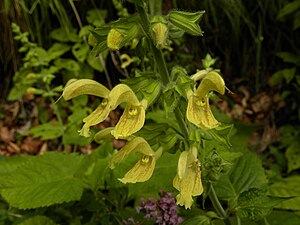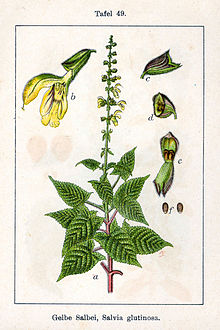Sticky sage
| Sticky sage | ||||||||||||
|---|---|---|---|---|---|---|---|---|---|---|---|---|

Sticky sage ( Salvia glutinosa ) |
||||||||||||
| Systematics | ||||||||||||
|
||||||||||||
| Scientific name | ||||||||||||
| Salvia glutinosa | ||||||||||||
| L. |
The Sticky sage ( Salvia glutinosa ), also Yellow sage and adhesives sage called, is a species of the large genus sage ( Salvia ) in the family of Labiatae (Lamiaceae). It is common in Eurasia .
description

Appearance and leaf
The sticky sage grows as a deciduous, perennial , herbaceous plant and reaches heights of 40 to 80, rarely up to 120 centimeters. Stems, leaves and sepals are sticky hairy ( indument ). The simple, strong and blunt 4-edged stem grows upright. In the lower area it is more or less bald, towards the top it develops a densely sticky and glandular hair. The sticky glandular hairs presumably fulfill a protective function against predators and small insects that are not used for pollination.
The 8 to 15 centimeters long leaves are arranged opposite to one another on the stem and have long stalks in the lower and middle sections of the stem, and often sessile in the upper. The pale green leaf blades are pike-ovate and the upper ones wedge-shaped; they have large, pointed ears . The leaf edge is roughly serrated irregularly.
Inflorescence, flower and fruit
The flowering period extends in midsummer from July to September. The total inflorescence consists of 6 to 16 pseudo-whorled partial inflorescences with four to six flowers each. The small bracts of the inflorescence are herbaceous with an oval-lanceolate blade . The flower stalk has a glandular downy hair.
The hermaphrodite flower is zygomorphic and five-fold with a double flower envelope . The five green, glandular hairy sepals are fused together like a bell and show an undivided, short and very broad upper lip . The vivid yellow colored and reddish brown dotted or striped corolla is 3 to 4.5 centimeters long. The corolla tube protrudes clearly. The upper lip resembles a sickle in shape. There are two stamens per flower .
The Klausen fruit breaks down into four Klausen . The Klausen have a length of 3.5 to 3.8 millimeters, a width of 1.8 to 2.0 millimeters and a thickness of 1.1 to 1.2 millimeters.
Chromosome set
The basic chromosome number is usually x = 8; there is mostly diploidy , i.e. 2n = 16.
ecology
Sticky sage is a mesomorphic to hygromorphic hemicryptophyte . He has a Pleiokorm - tap root as a storage organ. This means that sprouting is possible, but independent individuals in the sense of vegetative expansion do not arise. Basal axillary buds ensure the innovation. From an ecological point of view, it is about male "actual lip flowers" that offer nectar . Pollinators are bees and bumblebees , with bumblebees being the main pollinators.
Propagation units ( diasporas ) are usually the sticky chalices with the contained Klausen . They are subject to gravity propagation and fall as a whole from or stay on by grazing animals and humans liable (Velcro spread, bur ). The seeds are cold and dark germs . The fruit ripens from September to November.
Synecology
The owl butterfly caterpillars of the brass owl and the golden owl use the leaves of the sticky sage as a source of food. Both species live polyphagously on the plant. The Wasserdost gold owl is on the red list for early warning .
Occurrence
The sticky sage is widespread from southwest , central , eastern and southeastern Europe to the Caucasus and western Asia. There are localities for northern Spain , France (including Corsica ), Germany , Austria , Switzerland , Italy , Poland , the former Czechoslovakia , the former Yugoslavia , Hungary , Bulgaria , Albania , Greece , Armenia , Azerbaijan , Georgia , Ukraine , Crimea , the Turkey , northern Iran .
In Germany, the main deposits are in the southern Bavarian Alps and the Alpine foothills there . In the Allgäu Alps, the species in the Tyrolean part of the Rotwand near Elbigenalp rises up to 1700 m above sea level.
The sticky sage thrives in deciduous and mixed forests in the mountains of Central and Southern Europe. It especially thrives in shade and partial shade. He prefers fresh and sickerfeuchte ravine and riparian forests , forest edges and forest impacts . It thrives best on mostly lime-free soils that are rich in other basic cations . In Central Europe it is a Fagetalia order character.
Taxonomy
Salvia glutinosa was first published in 1753 by Carl von Linné in Species Plantarum 1, p. 26. Synonyms for Salvia glutinosa L. are: Sclarea glutinosa (L.) Mill. , Glutinaria glutinosa (L.) Raf. , Drymosphace glutinosa (L.) Opiz , Glutinaria acuminata Raf. The specific epithet glutinosa means sticky.
use
In contrast to real sage , sticky sage has no proven medical applications. The aromatic leaves are sometimes added to country wines as a flavoring agent. The sticky sage is also cultivated as an ornamental and wild garden plant, especially as a ground cover . Suspended plants are suitable as "biological" fly and mosquito catchers.
swell
Individual evidence
- ↑ a b Profile and distribution map for Bavaria . In: Botanical Information Hub of Bavaria .
- ↑ a b c d e f g h i j Salvia glutinosa L., sticky sage. In: FloraWeb.de.
- ↑ a b c d e f Salvia glutinosa L. - Lamiaceae - Sticky Sage - Entry in BiolFlor database of biological-ecological characteristics of the flora of Germany . ( Memento of the original from May 22, 2016 in the Internet Archive ) Info: The archive link was inserted automatically and has not yet been checked. Please check the original and archive link according to the instructions and then remove this notice.
- ↑ a b Salvia glutinosa - entry at Tela botanica - Le réseau de la botanique francophone .
- ^ Salvia glutinosa at Tropicos.org. In: IPCN Chromosome Reports . Missouri Botanical Garden, St. Louis
- ↑ a b c Eckehart J. Jäger (Ed.): Exkursionsflora von Deutschland. Vascular plants: baseline . Founded by Werner Rothmaler. 20th, revised and expanded edition. Spektrum Akademischer Verlag, Heidelberg 2011, ISBN 978-3-8274-1606-3 , p. 679 .
- ↑ a b Ruprecht Düll , Herfried Kutzelnigg : Pocket dictionary of the plants of Germany and neighboring countries. The most common Central European species in portrait . 7th, corrected and enlarged edition. Quelle & Meyer, Wiebelsheim 2011, ISBN 978-3-494-01424-1 .
- ↑ a b Rafaël Govaerts (Ed.): Salvia glutinosa. In: World Checklist of Selected Plant Families (WCSP) - The Board of Trustees of the Royal Botanic Gardens, Kew . Retrieved May 27, 2015.
- ^ A b c Salvia glutinosa in the Germplasm Resources Information Network (GRIN), USDA , ARS , National Genetic Resources Program. National Germplasm Resources Laboratory, Beltsville, Maryland. Retrieved May 28, 2015.
- ↑ Erhard Dörr, Wolfgang Lippert : Flora of the Allgäu and its surroundings. Volume 2, IHW, Eching 2004, ISBN 3-930167-61-1 , p. 416.
- ^ Erich Oberdorfer : Plant-sociological excursion flora for Germany and neighboring areas . With the collaboration of Angelika Schwabe and Theo Müller. 8th, heavily revised and expanded edition. Eugen Ulmer, Stuttgart (Hohenheim) 2001, ISBN 3-8001-3131-5 , pp. 809 .
- ^ Linnaeus scanned in at biodiversitylibrary.org in 1753 .
- ^ Salvia glutinosa at Tropicos.org. Missouri Botanical Garden, St. Louis, accessed on May 28, 2015.
- ↑ Salvia glutinosa at Plants For A Future
Web links
- Salvia glutinosa L., glutinous sage. In: FloraWeb.de.
- Sticky sage . In: BiolFlor, the database of biological-ecological characteristics of the flora of Germany.
- Salvia glutinosa L. In: Info Flora , the national data and information center for Swiss flora . Retrieved February 21, 2016.
- Thomas Meyer: Sage data sheet with identification key and photos at Flora-de: Flora von Deutschland (old name of the website: Flowers in Swabia )
- Günther Blaich: data sheet with photos.
- Gerhard Nitter: data sheet with photos.





